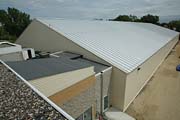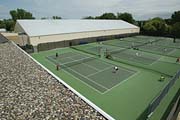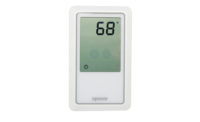
White Bear Racquet & Swim (WBRS) club is located in a part of the country where patrons are accustomed to trudging through heavy snows and below-zero wind chills to reach a warm oasis where they can work out to stay fit and trim. But keeping the facility itself warm and toasty through an arctic winter in White Bear, MN, is neither easy nor-until recently-inexpensive.
In Jan. 2001, WBRS found itself saddled with a $5,590 heating bill for its aging, five-court tennis "bubble" structure, which sat adjacent to the main building. With such hefty utility costs, it is little wonder that management decided to replace the old bubble with a new, well-insulated, five-court metal building constructed during the summer of 2002. But instead of conventional forced-air heating, the new facility is equipped with an in-court radiant heating system in which warm water is supplied by six ground source heat pumps.
The result: a jaw-dropping reduction in energy costs. During Jan. 2004, when temperatures plunged to -10
Why Radiant?
As the name implies, forced-air systems rely on blowers to deliver the heat. "With air blowing on you, even when the blowers are 50 feet away, 62 degrees is not that comfortable," Steinhauser explains.The club also wanted to avoid the kind of air-stratification problems it experienced in the old bubble, where the ceiling in winter was often 10 or more degrees warmer than the floor, Steinhauser recalls. A metal building with 36-ft.-high ceilings would likely suffer similar temperature variances.
The new in-court radiant system minimizes stratification by positioning a temperature sensor 35 feet high inside the tennis facility. The sensor feeds information to a DDC digital system, which uses the data to modulate the temperature of the water flowing to the courts from the heat pumps. The happy results: WBRS has never experienced more than a three-degree difference between floor and ceiling. Heat radiates evenly from the floor itself, warming players and objects on its surface, not the air 36 feet above.
"We care only about heating the bottom seven feet where our members are playing tennis," says Steinhauser. "We don't want to pay to heat the air where only the lobs go. At the same time, because radiant uses no air movement, 62 degrees is a perfectly comfortable indoor temperature, helping to lower our fuel consumption."
Finally, in-court radiant heating is silent because it doesn't use air blowers to circulate the warmth through the ambient air. "Our quiet playing conditions allow for the players to concentrate on their game or simply enjoy their conversations," says Steinhauser.
Designed and manufactured by Uponor Wirsbo of Apple Valley, MN, the tennis court's radiant system consists of approximately 42,000 feet of 5/8-inch hePEX™ plus tubing that was installed atop a two-inch layer of Styrofoam spanning the floor. The tubing was then covered by 3 inches of agricultural lime, on top of which is a special court surface comprised of carpet, sand, a binder and the court surface paint.
Mechanical Energy Systems of nearby St. Cloud was the installer of the radiant system and the piping that connects it to the six heat pumps. According to General Manager Kevin Johnson, his firm does "five to eight snow-melting projects annually, as well as a wide range of residential and commercial radiant in-floor heating installations. But the tennis facility at White Bear ranks as one the largest radiant jobs we have ever done."

Radiant Heating and Air Conditioning
Still, the project is remarkable for more than its size, adds Johnson, referring to its use of six heat pumps to furnish warm water for radiant heating during the cold months. These pumps are also reversible, providing air conditioning through five air handlers in summer. At the appropriate time, the valves to the radiant system are shut down and another set of valves to the air handler are opened, so that cold water can be pumped to it.
The pumps derive their water from a horizontal loop field built by another contractor in a wetland located adjacent to the tennis facility. The loops consist of 1-inch plastic pipe coiled into 120-ft.-long trenches that run horizontally nine feet below ground level. "They call them "
Payback Time
The cost to construct the new tennis facility was approximately $600,000 more than erecting a new bubble. However, the metal building should last more than 50 years, or three times the life span of a comparably sized bubble. Meanwhile, the $40,000 in anticipated annual energy savings will pay the difference between the two systems in 15 years (at today's price of natural gas). With the club's $150,000 increase in tennis-related revenues in 2003 over 2001 (2002 was the construction year), "we expect to earn back the difference between the cost of the building compared to a bubble in roughly four years," says Steinhauser.The new tennis facility is part of the club's overall emphasis on total environmental health within its facilities. WBRS management expects club operations to be fossil-fuel-free by 2010 on the way to becoming a "fully sustainable company," says Steinhauser. "That means using only renewable energy and other renewable sources, while putting no toxic, non-biodegradable materials into the waste stream. The goal is never to add anything to our environment-nor to cause anyone else to add something to our environment-that would compromise our members' health and well-being."
Steinhauser admits that full sustainability is a lofty objective: "No such company exists today, but the technology to accomplish this goal does exist and is becoming more viable each passing day."
With revenues up and fuel bills dramatically down, WBRS management is pleased with its decision to build a new and different kind of facility, rather than taking the less costly route of another bubble. "The comfortable playing conditions, including the warmth and quiet of radiant heat, have allowed us to grow our tennis business while reducing our impact on the environment," says Steinhauser. "We have found that getting in step with our environment can result in both better business and better life experiences for everyone."
For more information on Uponor Wirsbo's radiant systems, visit www.wirsbo.com.
